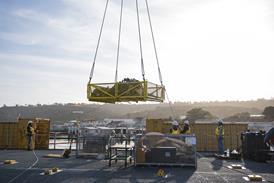Tim Furniss/LONDON
Dust from the comet Wild 2 will be collected and returned to earth by the fourth mission in NASA's Discovery programme which kicks off with a Delta II launch from Cape Canaveral in Florida on 6 February. It will be the first time that samples from a body in space (other than the earth's moon) will have been returned to the planet.
As the other goal of the $200 million mission is to gather small grains of interstellar matter, the craft has been named Stardust. Understanding the morphology of comet dust and the make-up of interstellar dust will help answer some of the fundamental questions about the creation of the universe and of the solar system.
The Stardust will use a series of a gravitational assisted fly-bys of the earth to make its way to Wild 2. It will be placed into an initial orbit and, with the aid of an engine firing, will be propelled into a huge elliptical orbit around the earth, making two revolutions before a third and closer approach in June 2003. This will coincide with an engine firing to divert the craft on its heading for a relatively slow (6.1 km/s) rendezvous with the Wild 2 in January 2004, as the comet approaches the sun.
The gravity-assist profile was chosen not only to allow the slower Wild 2 fly-by, but also to maximise the time for dust collection and allow the use of a smaller launcher for the relatively low-cost mission.
The 100km fly-by of the comet will be part of a 10h flight through the Wild 2's 200,000km-wide "coma", which comprises material shed from the comet's nucleus - basically a dirty snowball with a rocky core - forming a tail in the comet as it is heated while passing close to the sun. Key to the success of Stardust is ultra-low-density silica aerogel - a "sticky" material mounted like a communications dish on a mast which will be extended from a sample return capsule (SRC) as the craft approaches the comet.
As the Stardust passes the Wild 2, coma dust in the 1-100 micron range will be captured on one side of the Aerogel Dust Collector. The Stardust will also collect interstellar dust encountered at a velocity of 30km/s. This material will be gathered on the other side of the dust collector at other various times of the mission.
Also on board the Stardust is the Cometary and Interstellar Dust Analyser (CIDA), which will provide real-time mass spectral data of the particles, and a Dust Impact Monitor. The CIDA is derived from the particle impact analyser carried on the successful UK-built European Space Agency spacecraft Giotto, which made a close fly-by of Halley's Comet in March 1986. This will also monitor the comet's general environment.
The Stardust's innovative Optical Navigation Camera will be used as a bonus to return images of the nucleus of the Wild 2 with a resolution of about 6m, as well as detailed images of the coma dust streams. It is not known what the size of the nucleus of the comet is, but at 6km across, it would fill one pixel of an image taken at a distance of 100,000km.
WILD OBJECTIVE
The objective of the Wild 2 encounter is to recover more than 1,000 particles larger than 15 microns in diameter, as well as volatile molecules on the same capture medium.
Collecting fresh interstellar grains at various phases of the flight is aimed at capturing more than 100 particles in the 0.1-1 micron size. Comet and interstellar samples will be collected in a manner designed to preserve the elemental and isotopic composition of the material. Vital to the mission's success is the return of the samples to earth in January 2006, requiring the other major innovation for the 303kg (670lb) spacecraft. The 25kg SRC will be released from the main spacecraft about 3h before re-entry into the earth's atmosphere, while the main craft performs a divert manoeuvre to force it to fly past the earth.
The SRC will encounter the earth's atmosphere at a velocity of 12.8km/s, at an altitude of 125km. Protected by an aeroshell heatshield which will dissipate 99% of the kinetic energy, the capsule will deploy its parachute10min later, landing within a 60 x 6.5km footprint in the Utah Test and Training ground.
DISCOVERY MISSIONS
The Stardust is the fourth mission in NASA's "faster, better, cheaper" Discovery programme. The first Discovery mission was the Mars Pathfinder - originally to be the first craft in the Mars Environmental Survey Network programme and which landed on the planet in July 1997.
The second Discovery mission is the Lunar Prospector, which has been orbiting the earth's moon for just over a year. The craft has been surveying the moon's chemical characteristics and has indicated that water ice may lie beneath the surface in the polar regions. The third Discovery mission is the Near Earth Asteroid Rendezvous spacecraft. This missed its orbit of asteroid 433 Eros on 10 January after an engine failure, but it is expected to enter orbit around Eros by February next year (Flight International, 6-12 January). The fifth and sixth missions are the Comet Nucleus Tour, Contour, and Genesis, a craft to collect samples of solar wind. Five candidate missions for the seventh and eighth flights in the Discovery programme have also been selected.
These are the Aladdin, which is designed to gather tiny samples of the Martian moons, Phobos and Deimos; the Deep Impact, to fly a projectile into the comet P/Tempel 1; the Inside, a Jupiter orbiter to fly within the giant planet's turbulent atmosphere; the Messenger, a Mercury orbiter; and the Vesper, a Venus-orbiting spacecraft.
Source: Flight International























